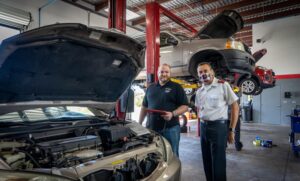
Modern cars are equipped with a plethora of electronic systems that govern almost every aspect of the vehicle’s functioning. From the engine management system to the infotainment system, everything is controlled by a complex network of electronic components. While this has made driving more comfortable and safer, it has also made cars vulnerable to hacking. Car hacking is a serious threat that can compromise the safety and security of the occupants as well as the vehicle itself. In this article, we will discuss the risks associated with car hacking and how to protect your vehicle from it.
The Risks of Car Hacking
Car hacking refers to the unauthorized access of a vehicle’s electronic systems by an attacker. The attacker can exploit vulnerabilities in the system to gain control of the vehicle and perform malicious actions. The risks of car hacking are numerous and can have severe consequences. Some of the risks associated with car hacking are:
- Remote control: An attacker can gain remote access to a vehicle’s electronic systems and take control of it. This can enable the attacker to manipulate the vehicle’s speed, direction, and braking, putting the occupants in danger.
- Data theft: Modern cars are equipped with a lot of sensors that collect data about the vehicle and its occupants. An attacker can exploit vulnerabilities in the system to steal this data, which can include personal information, location data, and driving habits.
- Ransomware: An attacker can use ransomware to lock the vehicle’s electronic systems and demand a ransom from the owner to unlock it.

- Malware: An attacker can use malware to infect the vehicle’s electronic systems and use it to launch attacks on other systems.
Protecting Your Vehicle from Car Hacking
Protecting your vehicle from car hacking requires a multi-layered approach that involves both software and hardware solutions. Some of the ways to protect your vehicle from car hacking are:
- Keep your software up-to-date: Car manufacturers regularly release software updates to fix vulnerabilities in the system. It is essential to keep your software up-to-date to ensure that your vehicle is protected from the latest threats.
- Use strong passwords: If your vehicle has a password-protected system, use a strong and unique password that is difficult to guess.
- Disable unnecessary features: If your vehicle has features that you do not use, it is better to disable them. This reduces the attack surface and makes it more difficult for an attacker to gain access to your vehicle.
- Use anti-virus software: Just like your computer, your vehicle’s electronic systems can also be protected by anti-virus software. Install a reputable anti-virus software that can detect and remove malware.
- Use a Faraday cage: A Faraday cage is a metal mesh that blocks electromagnetic signals. You can use a Faraday cage to shield your vehicle’s electronic systems from external signals, making it more difficult for an attacker to gain access to your vehicle.
Car hacking is a serious threat that can compromise the safety and security of your vehicle and its occupants. By understanding the risks associated with car hacking and taking the necessary precautions, you can protect your vehicle from this threat. Keep your software up-to-date, use strong passwords, disable unnecessary features, use anti-virus software, and use a Faraday cage. By implementing these measures, you can ensure that your vehicle is protected from car hacking.





